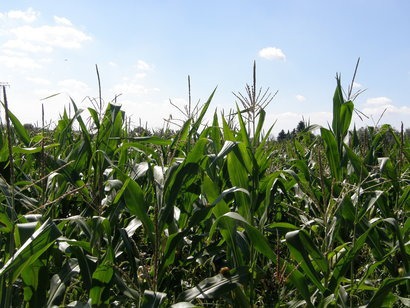
Maize cultivation in the UK is becoming more widespread, and it’s damaging the soil according to The Soil Association in a new report. In 1973, just 8,000 hectares of maize was grown in England, but over the period 1990 to 2000 the total acreage trebled and has continued to increase ever since. In 2014, 183,000 hectares of maize was grown in the UK. The reason for the massive growth of maize cultivation is the introduction of more resilient varieties enabling the crop to be grown in northern England.
Maize is best suited to warmer environments, but more resilient varieties means that more farmers in the UK can now grow the crop. It can be used as a relatively low-cost, reliable source of silage for cattle and in fact the majority of maize grown in the UK is for that exact purpose. Increasingly, maize farming is targeting the anaerobic digestion (AD) sector and that in turn has increased the demand.
The Soil Association says that because maize is a tall crop that has to be widely spaced, it leaves large areas of soil exposed during the growing season. Maize is harvested late in the year when the soil is often wet and this is carried out using tractors with trailors that have to be frequently rotated. These vehicles compact the soil which in turn enables heavy rain to simply run off the surface of fields rather than soaking into them. This then contaminates water courses with pesticides and nutrients in addition to causing floods. The Soil Association cites in its argument, research published in 2014 which found that 75 percent of late-harvested maize fields showed high or severe levels of soil degradation. One of the co-authors of that report, Robert Palmer, estimated that during the storms and heavy rainfall of the winter of 2013-14, every 10-hectare block of damaged land under maize stubble produced the equivalent of 15 Olympic swimming pools (more than 375 million litres) of enhanced runoff.
“Maize crops damage soils and fresh water” said Peter Melchett, policy director at the Soil Association. “Many farmers are being paid to cause significant harm to the vital resources we rely on for survival -this is a national scandal. The UK government must take action by ending subsidies for maize grown for energy and by introducing strict measures for management of maize crops. It is possible to grow maize to better practice standards that reduce the risks to soils and the environment -some farmers are following good practice, but not enough of them.”
However, the Soil Association’s argument has been criticised by the Anaerobic Digestion & Bioresources Assocation (ADBA).
“As the Committee on Climate Change has recognised, we need bioenergy to meet our climate change targets as well as to keep the lights on, and biogas is one of the most efficient forms available” said ABDA’s Chief Executive, Charlotte Morton. “The AD industry has the potential to reduce climate change emissions, including from farming, by as much as 4 percent and generate around 30 percent of the UK’s domestic gas demand. Whilst the AD industry has a huge contribution to make, in the context of farming the 30,000 hectares of maize grown for AD accounts for just 0.6 per cent of England’s total arable land, and less than a fifth of the total maize crop, most of which is used for forage.”
Ms Morton added that the AD industry takes its responsibility to the local environment seriously. By recycling the nutrients and organic matter in the digestate biofertiliser back to the land, the AD industry is helping to restore the UK’s soils thereby reducing the need for carbon-intensive commercial fertilisers. AD crops can also form a crucial component of a sustainable agricultural rotation, making break and cover crops a viable option for reducing fertiliser and pesticide use, while maintaining and enhancing biodiversity. ADBA members operating 34 plants have already signed up to use the Association’s Best Practice guidelines for Crop Feedstocks in AD, which was compiled with the support of Defra to demonstrate how crop AD can generate vital renewable energy while supporting the environment.
These guidelines acknowledge the risk to soils from maize and the requirement for a greater amount of post-harvest soil management to reduce the incidence of soil erosion, run-off, drainflow and run-through to ground water. They also make a number of recommendations to ensure these problems are minimised.
The National Farmers Union (NFU) wants to see an additional 125,000 hectares of maize grown in England by 2020 in order to grow crops for biofuel. The land used for this could instead be used to grow over 1 million tonnes of wheat or over 5.5 million tonnes of potatoes. Furthermore, a boom in maize production for anaerobic digestion could drive farmland rents up as is currently happening in Germany where rents have risen by 140 percent in just four years. This is now starting to happen in the UK.
However, The Soil Association is calling on the government to end the subsidies available to farmers growing maize for biofuel, replacing them with increased support for biogas produced from waste. The group is also calling for the removal of maize as a qualifying crop under the greening requirements for 30 percent of the new Common Agriculture Policy’s Basic Farm Payment and removal of the Basic Farm Payment for farmers growing maize for AD.
Charlotte Morton says this doesn’t make much sense since the Basic Payment Scheme (BPS) doesn’t allow for differentiation on the basis of how a crop is used, and farmers may not have control over this anyway. Amending the scheme would therefore be costly and virtually impossible – and models for renewable incentives use a crop price which assumes the BPS is in place so there is no double-counting.
For additional information:
'Runaway Maize - Subsidised Soil Destruction' (report, on PDF)

